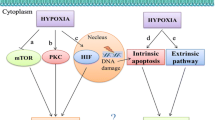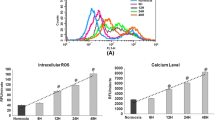Abstract
To elucidate mechanism of cell death in response to hypoxia, we attempted to compare hypoxia-induced cell death of HepG2 cells with cisplatin-induced cell death, which has been well characterized as a typical apoptosis. Cell death induced by hypoxia turned out to be different from cisplatin-mediated apoptosis in cell viability and cleavage patterns of caspases. Hypoxia-induced cell death was not associated with the activation of p53 while cisplatin-induced apoptosis is p53 dependent. In order to explain these differences, we tested involvement of μ-calpain and m-calpain in hypoxia-induced cell death. Calpains, especially μ-calpain, were initially cleaved by hypoxia, but not by cisplatin. Interestingly, the treatment of a calpain inhibitor restored PARP cleavage that was absent during hypoxia, indicating the recovery of activated caspase-3. The inhibition of calpains prevented proteolysis induced by hypoxia. In addition, hypoxia resulted in a necrosis-like morphology while cisplatin induced an apoptotic morphology. The calpain inhibitor prevented necrotic morphology induced by hypoxia and converted partially to apoptotic morphology with nuclear segmentation. Our result suggests that calpains are involved in hypoxia-induced cell death that is likely to be necrotic in nature and the inhibition of calpain switches hypoxia-induced cell death to apoptotic cell death without affecting cell viability.







Similar content being viewed by others
References
Brown JM, Giaccia AJ (1998) The unique physiology of solid tumors: opportunities(and problems) for cancer therapy. Cancer Res 58:1408–1416
Brizeland DM, Scully SP, Harrelson JM et al (1996) Tumor oxygenation predicts for the likelihood of distant metastases in human soft tissue sarcoma. Cancer Res 56:941–943
Shimizu S, Eguchi Y, Kosaka H, Wamiike W, Matsuda H, Tsujimoto Y (1995) Prevention of hypoxia-induced cell death by Bcl-2 and Bcl-xL. Nature 374:811–813
Kang PM, Haunstetter A, Aoki H, Usheva A, Izumo S (2000) Morphological and molecular characterization of adult cardiomyocyte apoptosis during hypoxia and reoxygenation. Circ Res 87:118–125
Yang DZ, Wang HJ (1997) Structural studies of interactions between anticancer platinum drugs and DNA. Prog Biophys Mol Biol 66:81–111
Victor M, Gonzalez MA, Fuertes CA, Perez JM (2001) Is Cisplatin-induced cell death always produced by apoptosis? Mol Pharm 59:657–663
Allday MJ, Inman GJ, Crawford DH, Farrell PJ (1995) DNA damage in human B cells can induce apoptosis, proceeding from G1/S when p53 is transactivation competent and G2/M when it is transactivation defective. EMBO J 14:4994–5005
Chu G (1994) Cellular responses to cisplatin. J Biol Chem 269:787–790
Gallagher WM, Cairney M, Schott B, Roninson IB, Brown R (1997) Identification of p53 genetic suppressor elements which confer resistance to cisplatin. Oncogene 14:185–193
Yuan Z, Shioya H, Ishiko T, Sun X, Gu J, Huang YY (1999) p73 is regulated by tyrosine-kinase c-Abl in the apoptotic response to DNA damage. Nature 399:814–817
Levine AJ (1997) p53, the cellular gatekeeper for growth and division. Cell 88:323–331
Giaccia AJ, Kastan MB (1998) The complexity of p53 modulation: emerging patterns from divergent signals. Genes Dev 12:2973–2983
Pluquet O, Hainaut P (2001) Genotoxic and non-genotoxic pathways of p53 induction. Cancer Lett 174:1–15
Graeber TG, Osmanian C, Jacks T et al (1996) Hypoxia-mediated selection of cells with diminished apoptotic potential in solid tumors. Nature 379:88–91
An WG, Meera K, Simon MC et al (1998) Stabilization of wild-type p53 by hypoxia-inducible factor-1alpha. Nature 392:405–408
Wang G, Hazra TK, Mitra S, Lee HM, Englander EW (2000) Mitochondrial DNA damage and a hypoxic response are induced by CoCl2 in rat neuronal PC12 cells. Nucleic Acids Res 28:2135–2140
Sarin A, Wu ML, Henkart PA (1996) Different Interleukin-1 Converting Enzyme (ICE) family protease requirements for the apoptotic death of T lymphocytes triggered by diverse stimuli. J Exp Med 184:2445–2450
Hampton MB, Fadeel B, Orrenius S (1998) Redox regulation of the caspases during apoptosis. Ann NY Acad Sci 854:328–335
Li M, Kondo T, Zhao QL et al (2000) Apoptosis induced by cadmium in human lymphoma U937 cells through cacium-calpain and caspase-mitochondria-dependent pathways. J Biol Chem 275:39702–39709
Waterhouse NJ, Finucane DM, Green DR et al (1998) Calpain activation is upstream of caspases in radiation-induced apoptosis. Cell Death Differ 5:1051–1061
Blomgren K, Zhu C, Wang X et al (2001) Synergistic activation of caspase-3 by m-calpain after neonatal hypoxia-ischemia: a mechanism of “pathological apoptosis”? J Biol Chem 276:10191–10198
Pelletier B, Dhainaut F, Pauly A, Zahnd JP (1988) Evaluation of growth rate in adhering cell cultures using a simple colorimetric method. J Biochem Biophys Methods 16:63–73
Qin LF, Irene OL (2002) Induction of apoptosis by cisplatin and its effect on cell cycle-related proteins and cell cycle changes in hepatoma cells. Cancer Lett 175:27–33
Wood DE (1998) Bax cleavage is mediated by calpain during drug-induced apoptosis. Oncogene 17:1069–1078
Kobayashi Y, Yamamoto K, Saido T, Kawasaki H, Oppenheim JJ, Matsushima K (1990) Identification of calcium-activated neutral protease as a processing enzyme of human interleukin 1 alpha. Proc Natl Acad Sci USA 87:5548–5552
Banasiaka KJ, Xia Y. Haddad GG (2000) Mechanisms underlying hypoxia-induced neuronal apoptosis. Prog Neurobiol 62:215–249
Ashcroft M, Taya Y, Vousden KH (2000) Stress signals utilize multiple pathways to stabilize p53. Mol Cell Biol 20:3224–3233
Koumenis C, Alarcon R, Hammond E et al (2001) Regulation of p53 by hypoxia: dissociation of transcriptional repression and apoptosis from p53-dependent transactivation. Mol Cell Biol 21:1297–1310
Hammond EM, Denko NC, Dorie MJ, Abraham RT, Giaccia AJ (2002) Hypoxia links ATR and p53 through replication arrest. Mol Cell Biol 22:1834–1843
Gao G, Dou OP (2001) N-terminal cleavage of Bax by calpain generates a potent proapoptotic 18-kDa fragment that promotes Bcl-2-independent cytochrome c release and apoptotic cell death. J Cell Biochem 80:53–72
Watters D (1999) Molecular mechanisms of ionizing radiation-induced apoptosis. Immunol Cell Biol 77:263–271
Han Y, Weinman S, Boldogh I, Walker RK, Brasier AR (1999) Tumor necrosis factor-a-inducible IkBa proteolysis mediated by cytosolic m-calpain. J Biol Chem 274:787–794
Kubbutat HG, Vousden K (1997) Proteolytic cleavage of human p53 by calpain: a potential regulator of protein stability. Mol Cell Biol 17:460–468
Chua BT, Guo K, Li P (2000) Direct cleavage by the calcium-activated protease calpain can cead to inactivation of caspases. J Biol Chem 27:5131–5135
Ruiz-Vela A, Gonzalez de Buitrago G, Martinez AC (1999) Implication of calpain in caspase activation during B cell clonal deletion. EMBO J 18:4988–4998
Bizat N, Hermel JM, Humber S et al (2003) In Vivo Calpain/Caspase cross-talk during 3-Nitropropionic acid-induced striatal degeneration. J Biol Chem 278:43245–43253
Han BS, Hong HS, Choi WS, Markelonis GJ, Oh TH, Oh YJ (2003) Caspase-dependent and –Independent cell death pathways in primary cultures of mesencephalic dopaminergic neurons after neurotoxin treatment. J Neurosci 23:5069–5078
Villa PG, Henzel WJ, Sensenbrenner M, Henderson CE, Pettmann B (1998) Calpain inhibitors, but not caspase inhibitors, prevent actin proteolysis and DNA fragmentation during apoptosis J Cell Sci 111:713–722
Jemmerson R, LaPante B, Treeful A (2002) Release of intact, monomeric cytochrome c from apoptotic and necrotic cells. Cell Death Differ 9:538–548
Bustamante J, Nutt L, Orrenius S, Gogvadze V (2005) Arsenic stimulates release of cytochrome c from isolated mitochondria via induction of mitochondrial permeability transition Toxicol. Appl Pharmacol 207:S110–S116
Aki T, Mizukami Y, Oka Y, Yamaguchi K, Uemura K, Fujimiya T, Yoshida K (2001) Phosphoinositide 3-kinase accelerates necrotic cell death during hypoxia. Biochem J 358:481–487
Aki T, Yoshida K, Fujimiya T (2002) Phosphoinositide 3-kinase accelerates calpain-dependent proteolysis of fodrin during hypoxic cell death. J Biochem 132:921–926
Donkor IO (2000) A survey of calpain inhibitors. Curr Med Chem 7:1171–1188
Haraguchi M, Torii S, Matsuzawa S et al (2000) Apoptotic protease activating factor 1 (Apaf-1)–independent cell death suppression by Bcl-2. J Exp Med 191:1709–1720
Sperandio S, Belle ID, Bredesen DE (2000) An alternative, nonapoptotic form of programmed cell death. Proc Natl Acad Sci USA 97:14376–14381
Oppenheim RW, Flavell RA, Vinsant S, Prevette D, Kuan CY, Rakic P (2001) Programmed cell death of developing mammalian neurons after genetic deletion of caspases. J Neurosci 21:4752–4760
Formigli L, Papucci L, Tani A et al (2000) Aponecrosis: Morphological and biochemical exploration of a syncretic process of cell death sharing apoptosis and necrosis. J Cell Physiol 182:41–49
Harriman JF, Liu XL, Aleo MD, Machaca K, Schnellmann RG (2002) Endoplasmic reticulum Ca(2+) signaling and calpains mediate renal cell death. Cell Death Differ 9:734–741
Lu T, Xu Y, Mericle MT, Mellgren RL (2002) Participation of the conventional calpains in apoptosis. Biochim Biophys Acta 1590:16–26
Nakagawa T, Yuan J (2000) Cross-talk between two cysteine protease families. Activation of caspase-12 by calpain in apoptosis. J Cell Biol 150:887–894
Liu X, Zou H, Slaughter C, Wang X (1997) DFF, a heterodimeric protein that functions downstream of caspase-3 to trigger DNA fragmentation during apoptosis. Cell 89:175–184
Sahara S, Aoto M, Eguchi Y, Imamoto N, Yoneda Y, Tsujimoto Y (1999) Acinus is a caspase-3-activated protein required for apoptotic chromatin condensation. Nature 401:168–173
Sakahira H, Enari M, Nagata S (1998) Cleavage of CAD inhibitor in CAD activation and DNA degradation during apoptosis. Nature 391:96–99
Counis MF, Torriglia A (2000) DNases and apoptosis. Biochem Cell Biol 78:405–414
Quignon F, De Bels F, Koken M, Feunteun J, Ameisen JC, de The H (1998) PML induces a novel caspase-independent death process. Nat Genet 20:259–265
Zamzami N, Kroemer G (1999) Condensed matter in cell death. Nature 401:127–128
Acknowledgments
We thank Dr. Kyungsook Ahn for her help in editing this manuscript. This work was supported by R01-2004-000-10803-0 from the Basic Research Program of the Korea Science & Engineering Foundation.
Author information
Authors and Affiliations
Corresponding author
Rights and permissions
About this article
Cite this article
Kim, MJ., Oh, SJ., Park, SH. et al. Hypoxia-induced cell death of HepG2 cells involves a necrotic cell death mediated by calpain. Apoptosis 12, 707–718 (2007). https://doi.org/10.1007/s10495-006-0002-3
Received:
Accepted:
Published:
Issue Date:
DOI: https://doi.org/10.1007/s10495-006-0002-3




